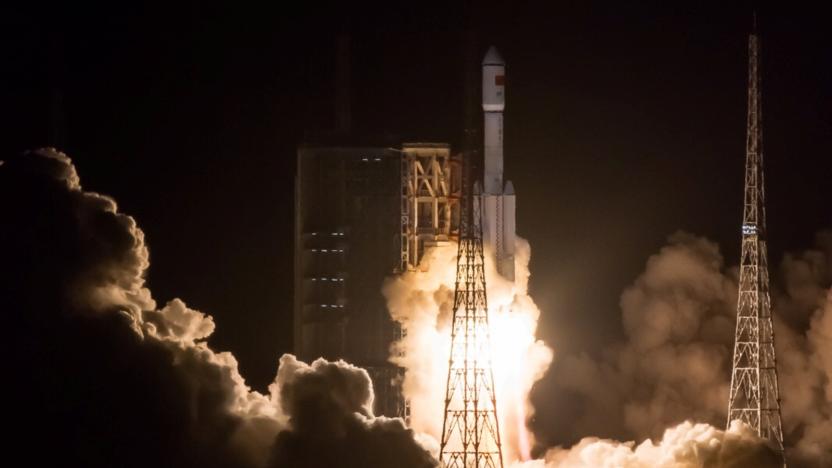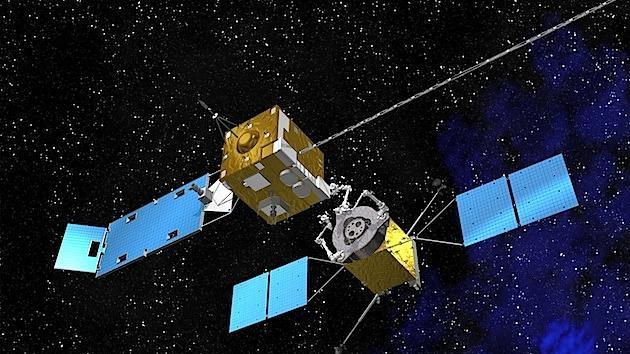refueling
Latest

Boeing's tanker drone completes first flight with refueling pod
Boeing has flown its MQ-25 mid-air refueling drone with a fuel pod for the first time, bringing it one step closer to mid-air top-ups for combat aircraft.

US Army wants helicopters to refuel at robotic pumps
Militaries regularly set up fueling stations at forward bases so that helicopters can get back to the fight as quickly as possible. However, requiring fuel crews creates huge risks and logistical headaches: you're sending people to a dangerous, isolated section of the battlefield for a fairly mundane role. Thankfully, the US Army might not need to take that risk for much longer. It's testing an unmanned station, the Autonomous & Robotic Remote Refueling Point (AR3P for short), that can top up a helicopter with no human involvement. Much like Tesla's robotic charger, it would use self-aligning, articulated arms to hook a fuel line to a helicopter all by itself. That, in turn, would let helicopters fly at all hours without putting footsoldiers in harm's way, and would likely refuel them faster.

China successfully refuels a satellite in orbit
China is now one of the precious few countries that knows how to refuel satellites in space. The nation's Tianyuan-1 system (launched aboard the Long March 7) has successfully topped up at least one satellite in orbit. Officials aren't describing the process beyond likening it to that for airplanes, but the result is clear: the refueling should help satellites stay in orbit for longer, or make adjustments that would otherwise be impractical.

NASA's building a satellite refueling robot platform that works... in space
Currently, every satellite put into orbit will become interstellar refuse, destined to be tracked (and perhaps dismantled) by DARPA or eventually disposed of by gigantic lasers (maybe). Naturally, NASA's not so keen on such waste, and it knows that many satellites' shelf lives can be extended with the addition of more fuel. Enter the Remote Robotic Oxidizer Transfer Test (RROxiTT), a project aimed at building a robot platform capable of refilling satellite fuel tanks both on earth and in space. To make it happen, scientists are working out a method for delivering highly combustible oxidizer (aka a chemical used to ignite rocket fuel) to satellites that were not designed to be serviced. Oh, and they need to be able to do it remotely and safely, of course. And that latter bit is a particular sticking point, as oxidizers are "toxic, extremely corrosive and compressed" according to NASA, which is why the system is being developed for use both on land and in orbit -- why put a human in harm's way when a robot can do the job, right? Image Credit: NASA

Canada's Dextre robot refuels faux satellite from the ISS in first-of-a-kind test
Move over, Canadarm. You may have helped the space shuttle fleet repair the Hubble Telescope and build the International Space Station, but there's another robotic tool that's the apple of the Great White North's eye. Dextre, the Canadian Space Agency's dual-armed mechanical "handyman," has successfully refueled a faux satellite from the ISS as part of NASA's and the CSA's joint Robotic Refueling Mission. Not only did the exercise demonstrate how satellites could be juiced up in space and have their lives extended, but the CSA says it's a first for the history books, to boot. Since 2011, Dextre completed a trio of tests to show how it could service satellites that weren't built for being pried opened in space. Late this week, NASA and CSA robotics controllers removed two safety caps from a washing machine-sized mock satellite, snipped two sets of retaining wires and pumped in a bit of ethanol. Sure, you could take a Frankenstein-like approach and cobble together new satellites from old ones, but Dextre's trials indicate there's promise for a proactive tactic that would keep existing hardware humming.

NASA robotic gas station successfully installed -- our Jetsonian dreams (almost) fulfilled
So we won't be zipping around with wife and kids in a flying car anytime soon, but NASA brought us ever closer to a Jetsonian future, yesterday, with the installation of its Robotic Refueling Mission (RRM) experiment. Fifteen minutes into their spacewalk, Mike Fossum and Ron Garan successfully installed the appropriate hardware on the International Space Station for pumping fuel to satellites in space. Using the Canadian-born Dextre (aka Special Purpose Dextrous Manipulator) as a gas station attendant, the RRM will eventually be used to refuel and perform minor repairs to satellites in orbit, potentially extending the time they can stay aloft. Now that that's underway, how 'bout y'all get to work on making Rosie a reality?

Shell opens America's first pipelined hydrogen-fueling station in Southern California
Residents of SoCal's Torrance should consider themselves lucky, as they're now living in America's first-ever city to have a pipelined hydrogen-fueling station. You can thank Shell and Toyota for picking up this government-funded green project. Sure, while the few other hydrogen stations still rely on delivery by supply truck (presumably running on diesel, ironically), this nevertheless marks a new milestone for our squeaky clean fuel, and it's only a matter of time before more stations get piped up to Air Products' hydrogen plants. If there's any indication of a time frame, Wired reminds us that 2015 should see the arrival of many new mass-market hydrogen cars from Toyota, Honda, and Mercedes-Benz. Not long to go now, fellow tree huggers.

NASA's Global Hawk completes unmanned airborne refueling simulation, will do it for real next year (video)
While some bot makers are busying themselves designing AI to simulate humans' natural and distinct lack of intelligence, it's nice to see there are still old-fashioned researchers out there keeping the Skynet dream alive. Northrop Grumman's aeronautics gurus have paired together a Global Hawk unmanned aircraft with a manned Proteus ship way up in the skies -- 45,000 feet, to be precise -- with the vessels of ingenuity managing to fly in tandem at a distance as short as 40 feet. Unsurprisingly, this is the first time such intimacy has been reached between UAVs (the Proteus had a monitoring crew on board to ensure the insurance bill wasn't through the roof) in high altitude, and the ultimate goal of having two Global Hawks doing the deed without any human intervention is said to be within reach by next year. That's when these light and agile air drones will be able to refuel themselves and go on for a mighty 120 hours in the air... plenty of time to complete a well planned extermination down below, if one were so inclined.

Orbiting fuel stations proposed for trips to the Moon, Mars, and beyond
A US government panel, summoned by el presidente to review the future of human space travel, has expressed strong support for introducing fuel depots into Earth's orbit. Refueling between stops is expected to cut down significantly on the weight of spacecraft and, accordingly, eliminate the need to engineer ever more powerful rockets to launch missions. It would then be up to private companies to compete -- and NASA already knows a thing or two about privatizing space missions -- by reducing costs and developing more efficient methods. While by no means the only potion NASA has bubbling, if the panel concludes in favor of orbiting gas stations, they will form the backbone of all future extraterrestrial exploration. So we're just letting you know in advance -- we're nice like that.

ASTRO satellite hooks spacecraft up with fuel whilst orbiting
Launching a few birds into space is quite a feat in its own right, but pumping hydrazine fuel into an orbiting counterpart autonomously is really something to be proud of. Just about a month after launching the two unmanned crafts into space, the ASTRO satellite "successfully pumped vital hydrazine fuel into its NextSat counterpart as part of Scenario 0-1, the first in a series of increasingly challenging tests." The machines are currently taking part in the series of Orbital Express missions, and apparently, things are on the up and up thus far. Future tests are slated to include "autonomous undocking, proximity operations and re-docking," as well as installing a battery on NextSat with its robotic arm. We can't wait to see what happens when one of the two gets testy about refueling after hours, but we sure hope the galactic battle is somehow caught on tape.[Via Digg]

Pair of new Ace Combat trailers
Ace Combat fans will be excited by the new (highly promotional) preview of the upcoming PSP-exclusive Ace Combat X on IGN. They reveal some of the features, such as the Medal System, Color Variation and Free Mission. The mini games listed include Touch and Go, Mid-Air Refueling Practice and Carrier Touch & Go. While it doesn't sound too exciting to me, I'm sure those of you that were fascinated by planes will be absolutely enthralled.If you don't really feel like reading about these features, IGN has also posted two new trailers of the game in motion. Graphically, it looks impressive, but it seems like that's a given for most PSP games these days. The game comes out in October.






